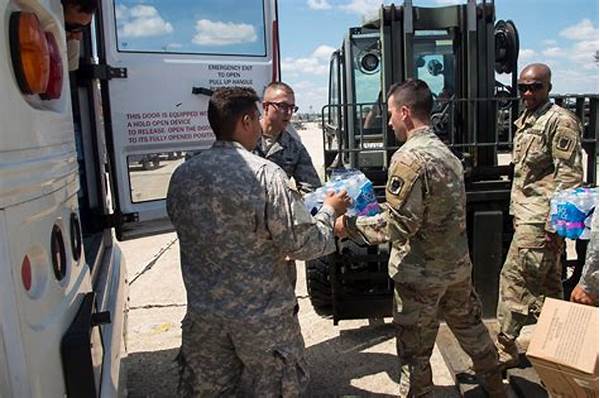The growing frequency and intensity of natural disasters have necessitated enhanced collaboration between various agencies to ensure effective response and recovery efforts. Among the collaborative approaches, joint military-civil partnerships in disaster relief have emerged as a pivotal strategy to harness the strengths of both military and civilian entities. This article provides a comprehensive overview of the role and significance of these partnerships in improving disaster response capabilities.
The Role of Joint Military-Civil Partnerships
Joint military-civil partnerships in disaster relief serve as a cornerstone for coordinated response efforts. These partnerships utilize the military’s logistical capabilities, including transportation, communication, and manpower, to complement the expertise of civilian agencies in areas such as medical care, environmental assessment, and social services. The integration of military and civilian resources ensures a holistic approach to disaster management, enhancing the speed and effectiveness of relief operations. In instances of natural calamities, such partnerships enable swift mobilization of resources, leading to immediate assistance for affected communities. Moreover, the synergy between military precision and civilian compassion facilitates a balanced approach to disaster response, addressing both immediate and long-term needs. Thus, joint military-civil partnerships in disaster relief are essential for fostering resilience and reducing vulnerability in disaster-prone regions.
Advantages of Joint Military-Civil Partnerships
1. Enhanced Coordination: Joint military-civil partnerships in disaster relief enhance coordination between diverse agencies, leading to more streamlined operations and resource allocation.
2. Rapid Response: These partnerships facilitate rapid deployment of resources and personnel, ensuring timely assistance to affected areas.
3. Resource Optimization: By combining military logistics with civilian expertise, resources are utilized optimally during disasters.
4. Comprehensive Coverage: Joint efforts ensure comprehensive coverage of affected regions, addressing both immediate humanitarian needs and long-term recovery.
5. Shared Expertise: Civilian agencies benefit from military training and discipline, while military units gain insights from civilian humanitarian and environmental expertise.
Challenges and Solutions
While joint military-civil partnerships in disaster relief present numerous benefits, they also encounter several challenges. One significant issue is the difference in organizational culture between military and civilian entities, which can lead to communication gaps and operational inefficiencies. To overcome this challenge, regular joint training exercises and workshops are essential to foster mutual understanding and build trust. Furthermore, legal and jurisdictional issues can complicate the deployment of military resources for civilian use. Therefore, establishing clear protocols and agreements before disaster strikes is imperative to ensure seamless cooperation. Through these efforts, joint military-civil partnerships can evolve into a well-coordinated force, ready to tackle the multifaceted challenges posed by disasters.
Importance of Pre-Disaster Planning
Effective joint military-civil partnerships in disaster relief rely heavily on pre-disaster planning. This involves the development of comprehensive disaster response plans that outline the roles and responsibilities of all stakeholders. Regular simulation exercises and drills are critical components of these plans, enabling military and civilian personnel to become familiar with each other’s capabilities and protocols. Additionally, continuous communication and information sharing between partners bolster preparedness and ensure that all parties are aligned in their objectives. By investing in rigorous pre-disaster planning, these partnerships can significantly reduce response times and enhance the overall efficiency of disaster relief operations.
Case Studies of Successful Partnerships
Numerous case studies highlight the effectiveness of joint military-civil partnerships in disaster relief. For instance, during the 2011 earthquake and tsunami in Japan, the collaboration between the Japanese Self-Defense Forces and civilian organizations played a crucial role in the rapid distribution of aid and evacuation of affected individuals. Similarly, the partnership between the United States military and civilian agencies during Hurricane Katrina demonstrated the potential for robust collaboration in disaster scenarios. These case studies underscore the importance of joint efforts in mitigating the impact of disasters, providing invaluable lessons for future operations.
Future Perspectives
The evolving landscape of environmental challenges necessitates a forward-looking approach to disaster relief strategies. Joint military-civil partnerships are expected to play an increasingly prominent role, leveraging technological advancements to enhance response capabilities. The integration of cutting-edge technologies such as drones, artificial intelligence, and satellite imagery will further strengthen the efficiency of these partnerships. Additionally, fostering international collaborations and knowledge exchange can enhance global disaster preparedness and response efforts. With continuous adaptation and innovation, joint military-civil partnerships in disaster relief will become more robust and agile, ready to tackle future challenges.
Summary
In conclusion, joint military-civil partnerships in disaster relief are instrumental in enhancing the effectiveness of response efforts. By combining the logistical strengths of military forces with the specialized skills of civilian agencies, these partnerships offer a comprehensive approach to disaster management. While challenges exist, proactive planning, mutual understanding, and continuous collaboration can overcome these hurdles, leading to successful outcomes. As the frequency and severity of disasters continue to rise, the importance of these partnerships cannot be overstated. Joint military-civil partnerships remain an essential element in building resilience and safeguarding communities against the impacts of natural catastrophes. Through diligent efforts and shared commitment, these partnerships will continue to evolve, ensuring swift and efficient responses to future disasters.





